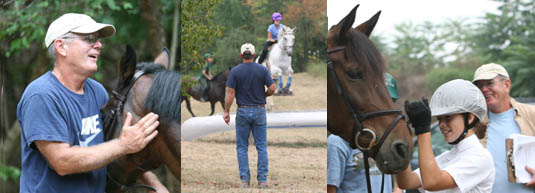
|
Our riding
program at the Triple Creek Farm is carried on in the military equestrian
tradition. We teach according to
dressage sportif principles that originated at the French Cavalry School at
Saumur France after the introduction of Caprilli’s Forward Seat concepts.
These methods were later refined and applied at the U.S. Cavalry School at Fort
Riley, KS. In this traditional approach to riding instruction, classical
dressage principles were applied to combat field riding, and today they are the
principles of the Balanced Seat used in contemporary polo, foxhunting, mounted
police work, and eventing.
Riding in America in the 1970s saw a huge shift in emphasis toward horse shows
and toward the Hunter/Jumper show seat. This show seat, while initially derived
from the traditional Balanced Seat, is an abbreviated specific method of riding.
The show ring is a flat surface with even footing, containing jumps that fall
away when struck. In this context, the more demanding aspects of the Balanced
Seat are not required. It was therefore practical for instructors like George
Morris to create changes and remove elements of the full scope of the Balanced
or Military Seat that was the American equestrian standard prior to the specialization of show
riders.
In
the more traditional equestrian sports, horses and riders face far
greater requirements than show riders because
of the greater variation in the challenges encountered in these sports. For example, the show rider is required to ride and balance only on the
flat plane of the show ring with its evenly raked footing. Eventers and
foxhunters must, in contrast, negotiate terrain with intense slopes, with
footing changes that include mud, rock, wet grass, granular shale, water and
pavement, to name a few. Also, they must jump from these varied footings over
solid obstacles like fences, walls, timbers, and ditches that are far less
forgiving than a show jump that will break away and fall down when there is an
error or accident.
|
 |
In short,
the traditional equestrian sports require a greater number of skills and a wider
range of techniques than are necessary for showing. Because of these differences
in the required skills the Hunter/Jumper Seat is inadequate for the more
challenging traditional equestrian sports, and therefore the riding student must
make a greater commitment to the learning process in order to learn the full
scope of the Balanced Seat.
That is why at Triple Creek Farm we say,
"Riding is a sport, not a hobby." |
|
The
commitment to the traditional Balance Seat requires a higher level of physical
fitness than the show seat. Riding using the Balanced Seat method is a more physical athletic
activity, not a hobby. Also, because of the inherent demands and tradition, the
rider must develop a mindset that is more athletic or martial in nature.
For
example, at the Saumur Cavalry School there is a sign that reads, “There are
no bad horses, only bad riders.” In other words, blaming the horse for failure
is not permitted. The words “My Horse won’t …”, which are so commonly
heard today at so many stables, are not spoken at Triple Creek Farm. Instead, the first person,
“I cannot get my horse to…” are the standard.
There
are other student requirements at Triple Creek Farm, like putting the horse’s
well being first, cleaning up after one’s self, clear respectful communication
and a constant emphasis on safety of the riders and horses in the more
challenging equestrian sports. These and other standards and requirements have
been established to develop riders of the highest quality with the kind of
character that is part of traditional old school horsemanship.
|
|

